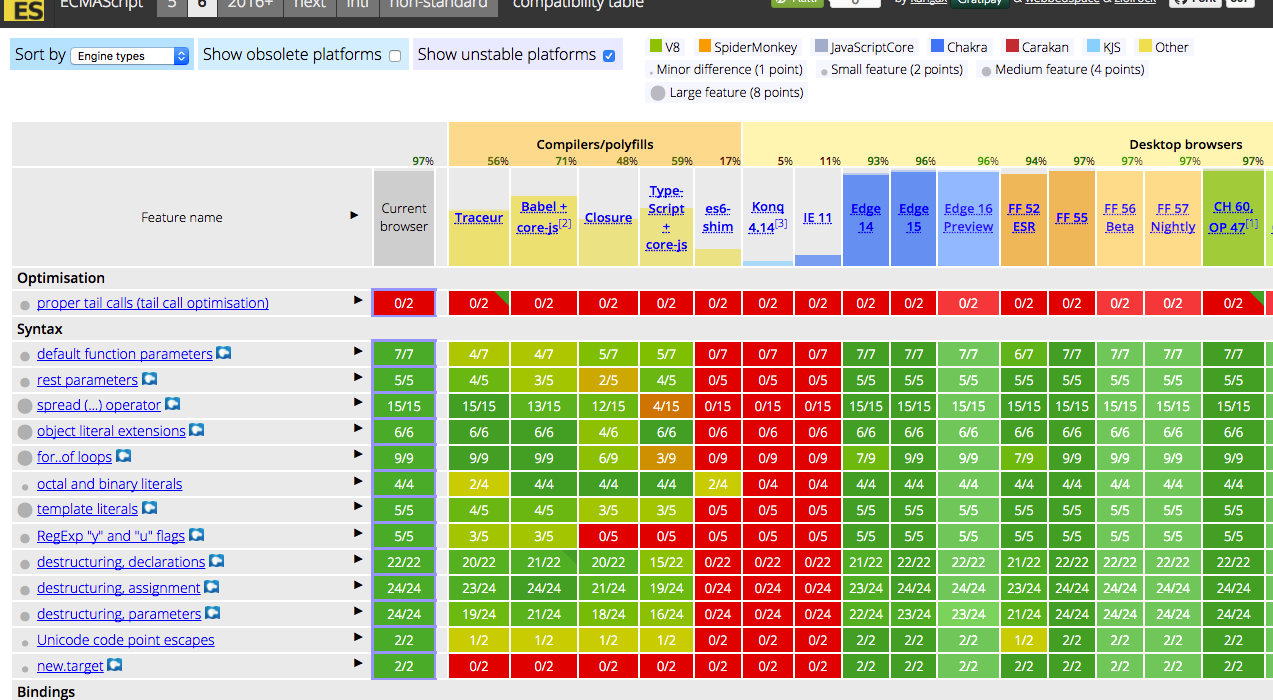ES2015
Você já deveria estar utilizando!

Yan Magalhães
- Full stack web developer na 4YouSee
- GDGBH Organizer
- FEMUG-MG Co-organizer
- Amante da Web
- Open Source
- F1 Fan
Olá!
AVISO:
Essa palestra terá muito código.
1.
Contexto

Ecmascript?
São os padrões, definições e funcionalidades que os browsers possibilitam para as nossas aplicações web.
EcmaScript International
Entidade responsável por votar e definir quais os padrões e novas funcionalidades
TC39
Harmony = ES6 = ES2015



Devemos (e podemos) utilizar HOJE!
E o que temos de novo?
- Block scoped
- Arrow Functions
- Template Strings
- Default Params
- Classes
E o que temos de novo?
- Modules
- Promises
- Map, Set
- Rest Params
- E muito, muito mais.
Blocked Scope
Adição das palavras reservadas let e const, para trabalhar melhor com o escopo de variáveis.
const PI = 3.141593
let event = "BH Tec Talks"
console.log(PI > 3.0);
PI = 2; //Uncaught TypeError: Assignment to constant variable.
function f() {
{
let x;
{
// okay, block scoped name
const x = "sneaky";
// error, const
x = "foo";
}
// error, already declared in block
let x = "inner";
}
}Arrow Function
Uma nova sintaxe para declaração de função.
let result = (a, b) => b*a;
console.log(result(10,2)); //20
const foo = () => 'bar'
const baz = (x) => {
return x + 1
}
const squareSum = (...args) => {
const squared = args.map(x => Math.pow(x, 2))
return squared.reduce((prev, curr) => prev + curr)
}
this.items.map(x => this.doSomethingWith(x))Template Strings
let name = 'Yan';
console.log(`Olá ${name} tudo bem?`);Default Params
let callMyName = (name="Yan",gretting="Hi ")
=> console.log(gretting,name);
callMyName(); // Hi YanClasses
Uma forma mais fácil, amigável e OO Like de se criar classes e métodos.
class Cliente {
constructor(nome, email) {
this.nome = nome;
this.email = email;
}
hello() {
return `Olá ${this.nome} tudo bem?`
}
send() {
return `Enviando email para ${this.email}...`
}
}
let pessoa = new Cliente('Yan', 'email@email.com');
console.log(pessoa.hello());//Ola Yan tudo bem?
console.log(pessoa.send());//Enviando email para email@email.com
E herança ??
class Character{
constructor(x,y){
this.x = x;
this.y = y;
this.health_ = 100;
}
damage(){
this.health_ -= 10;
}
getHealth() {
return this.health_;
}
toString() {
return "x: " + this.x + " y: " + this.y
+ " health: " + this.health_;
}
}class Player extends Character{
constructor(x,y,name){
super(x,y);
this.name = name;
}
move(dx, dy) {
this.x += dx;
this.y += dy;
}
toString(){
return "name: " + this.name
+ " " + super.toString();
}
}
//Work
var x = 10
var y = 20
var name = 'Yan';
var character = new Character(x, y);
character.damage();
console.log(character.toString()); // x: 10 y: 20 health: 90
var player = new Player(x, y, name);
player.damage();
player.move(7, 8);
console.log(player.toString()); // name: Yan x: 17 y: 28 health: 90
Modules
Escrever os componentes do seu projeto, reaproveitamento de código e estruturas modulares.
/* solution-math file */
export const PI = 3.141592;
var _sqrt = function(s, x, last){
return x != last
? _sqrt(s, (x + s / x) / 2.0, x) : x;
};
export function sqrt(s){
return _sqrt(s, s/2.0, 0.0);
};
export function square(x) {
return x * x;
};
/* module.js file */
/**
* Utilizing the solution-math
**/
var arg1 = 2;
var arg2 = 3;
import {PI, sqrt, square} from './solution-math';
//Load all code of solution-math
console.log(PI);
console.log(sqrt(+arg1)); //Float Number
console.log(square(+arg2)); //Float Number
Outras Opções



Promises
Uma feature para executar rotinas de forma assíncrona. É uma representação de um valor que pode ser disponibilizado no futuro.
São utilizadas em muitas bibliotecas Javascript.
readFilePromisified('config.json')
.then(function (text) { // (A)
const obj = JSON.parse(text);
console.log(JSON.stringify(obj, null, 4));
})
.catch(function (error) { // (B)
// File read error or JSON SyntaxError
console.error('An error occurred', error);
});
function msgAfterTimeout (msg, who, timeout) {
return new Promise((resolve, reject) => {
setTimeout(() => resolve(`${msg} Hello ${who}!`), timeout)
})
}
msgAfterTimeout("Gretting - ", "Yan", 100)
.then((msg) =>
msgAfterTimeout(msg, "BH TEC", 200))
.then((msg) =>
msgAfterTimeout(msg, "Talks", 400))
.then((msg) => {
console.log(`done after 600ms:${msg}`)
})
Um outro exemplo
Map and Set
// Sets
var s = new Set();
s.add("hello").add("goodbye").add("hello");
s.size === 2;
s.has("hello") === true;
// Maps
var m = new Map();
m.set("hello", 42);
m.set(s, 34);
m.get(s) == 34;
Rest Params
function f(x, ...y) {
// y is an Array
return x * y.length;
}
console.log(f(3, "hello", true) == 6); //trueDestructuring
const arr = ['one!', 'two!', 'three!', 'four!']
const [one, two, ...rest] = arr
const obj = {a: 'x', b: 'y', c: 'z'}
const {a, b, c} = objArray Spread
const foo = ['a', 'b', 'c']
const bar = ['d', 'e', 'f']
console.log(...foo)
console.log([...foo, ...bar])E o suporte dos navegadores?

http://kangax.github.io/compat-table/es6/
> 90% já suportado
https://babeljs.io/

ES2015 - Indo Além
- Enhanced Object Literals
- Iterators + For..Of
- Tail Calls
- Generators
- Unicode
- Module Loaders
- Proxies
- Symbols
- Binary and Octal Literals
- Math libraries, Array conversion helpers, String helpers
E tem mais features da linguagem?
2.
ES2016, ES2017 e ES2018
Static Class Properties
class Foo {
static bar = 'hello'
}
console.log(Foo.bar)Class Instance Properties
class Cat {
name = 'Tom'
state = {
running: true
}
constructor() {
console.log(this.name, this.state.running)
}
}
new Cat()Spread Object
const defaultStyle = {
color: 'black',
fontSize: 12,
fontWeight: 'normal'
}
const style = {
...defaultStyle,
fontWeight: 'bold',
backgroundColor: 'white'
}
// Note that fontWeight is 'bold', as the second
// assignment overrode the initial assignment.
console.log(style)Async Functions
const fetchData = async () => {
return fetch('https://randomuser.me/api/')
}
const printData = async () => {
try {
const data = await fetchData()
const json = await data.json()
console.log(json)
} catch(e) {
console.error("Problem", e)
}
}
printData()Dicas
- https://github.com/lukehoban/es6features
- https://github.com/yosuke-furukawa/tower-of-babel
- https://leanpub.com/understandinges6
- http://exploringjs.com/es6/
- https://babeljs.io
- https://github.com/YanMagale/ecma6-studies



/yanmagale
/yaanmagale
/yaanmagalhaes